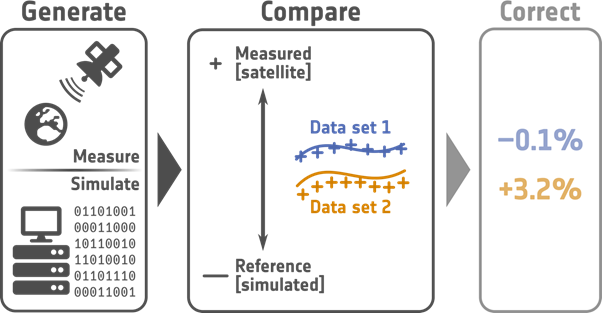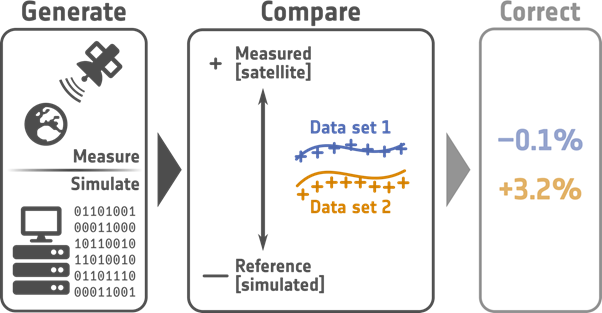The complexity of the Earth system requires ingenious modelling strategies to reduce the related expense of simulations - usually at the cost of accuracy. Eradiate, a new, highly accurate and flexible radiative transfer model in the optical domain, will help generate reference data for instrument calibration.
Earth observation (EO) data play an important part in the development of public policies. Therefore, it is of prime importance to ensure that these data are accurate and reliable: How certain can we be that images we look at are what they seem to be?
But let's take a step back, to understand what all this entails in regards to EO data. Much of these data come from satellite imagers, like those onboard the Sentinel-2 satellites of the European Union's Copernicus Programme. These instruments are sophisticated spaceborne cameras called radiometers, among several other techniques available on the satellites.
Just like any camera, radiometers record light originating from two sources: Sun light scattered by Earth, and light emitted by objects located on Earth. Every object on the Earth system, e.g. land and water surfaces, atmospheric gases and clouds, emits and scatters light in a unique way. This is what makes remote sensing possible.
Remote sensing is the art of interpreting images captured by airborne and spaceborne radiometers. Out of various pixel values, a date and location, experts try to infer facts about these objects, which scattered and emitted the light recorded by the radiometer.
The raw radiometric data are then processed for interpretation. Each measurement and processing step uses models, which are potential sources of uncertainty. Quantifying and keeping track of them is essential when it comes to assessing how accurate and reliable remote sensing data are, and this is part of the activities carried out in the scientific field of metrology.
In order to ensure that the data they record correctly reflects reality, optical radiometers must undergo a calibration process, consisting in comparing their output with a trusted reference. This process is particularly challenging for spaceborne instruments, because researchers cannot take them down to a lab.
Numerical simulation of light propagation also plays a pivotal role in instrument calibration and data validation, through the generation of physically accurate reference data, to which radiometer output can be compared.
Instruments put into service like radiometers onboard the Copernicus Sentinels, have reached unprecedented precision, challenging the scientific community on their ability to make best use of this accuracy.
This is where a new simulation tool comes in: Developed by the Brussels-based company, Rayference, in the framework of a Copernicus-funded ESA project, the Eradiate radiative transfer model will help with instrument calibration, by providing highly accurate simulated data.
Eradiate should allow to reach the numerical accuracy required to calibrate modern radiometric instruments, enabling remote sensing data providers to radiometrically correct data in order to improve the accuracy and reliability.
It leverages technology originally applied to computer graphics, mixing all kinds of geometry and objects, performing accurate radiative transfer simulations on them. It will be free software released under the GNU Public License.
This radiative transfer model is designed to support the enhancement of Copernicus Sentinel optical data. In addition, it could benefit multiple scientific communities dealing with Earth Observation data. The first beta release is scheduled for early 2021.
Yves Govaerts, Managing Director at Rayference, states, "Eradiate is a new endeavour at making a technological quantum leap in the field of radiative transfer for Earth observation, and will thus greatly improve highly accurate simulation data".
About the Copernicus Sentinels
The Copernicus Sentinels are a fleet of dedicated EU-owned satellites, designed to deliver the wealth of data and imagery that are central to the European Union's Copernicus environmental programme.
The European Commission leads and coordinates this programme, to improve the management of the environment, safeguarding lives every day. ESA is in charge of the space component, responsible for developing the family of Copernicus Sentinel satellites on behalf of the European Union and ensuring the flow of data for the Copernicus services, while the operations of the Copernicus Sentinels have been entrusted to ESA and EUMETSAT.

